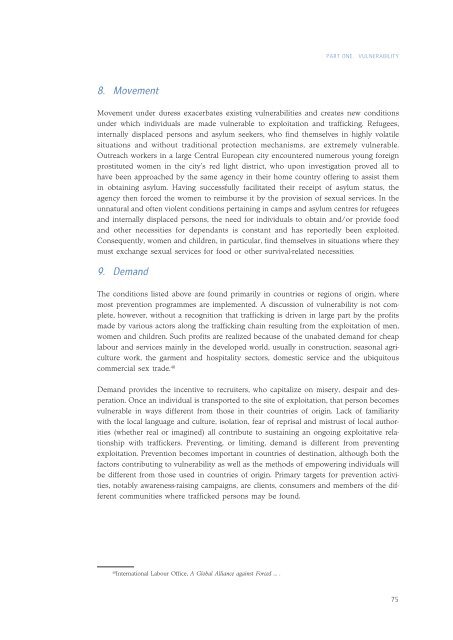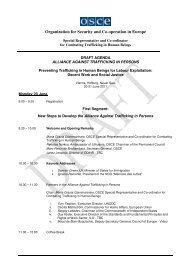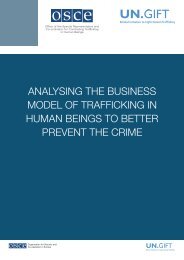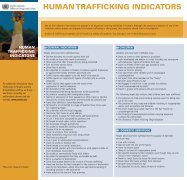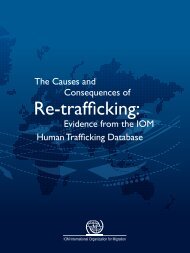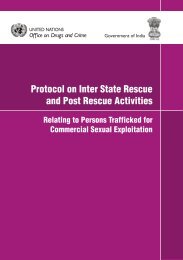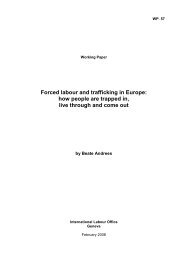An Introduction to Human Trafficking - United Nations Office on ...
An Introduction to Human Trafficking - United Nations Office on ...
An Introduction to Human Trafficking - United Nations Office on ...
Create successful ePaper yourself
Turn your PDF publications into a flip-book with our unique Google optimized e-Paper software.
PART ONE.—VULNERABILITY<br />
8.—Movement<br />
Movement under duress exacerbates existing vulnerabilities and creates new c<strong>on</strong>diti<strong>on</strong>s<br />
under which individuals are made vulnerable <str<strong>on</strong>g>to</str<strong>on</strong>g> exploitati<strong>on</strong> and trafficking. Refugees,<br />
internally displaced pers<strong>on</strong>s and asylum seekers, who find themselves in highly volatile<br />
situati<strong>on</strong>s and without traditi<strong>on</strong>al protecti<strong>on</strong> mechanisms, are extremely vulnerable.<br />
Outreach workers in a large Central European city encountered numerous young foreign<br />
prostituted women in the city’s red light district, who up<strong>on</strong> investigati<strong>on</strong> proved all <str<strong>on</strong>g>to</str<strong>on</strong>g><br />
have been approached by the same agency in their home country offering <str<strong>on</strong>g>to</str<strong>on</strong>g> assist them<br />
in obtaining asylum. Having successfully facilitated their receipt of asylum status, the<br />
agency then forced the women <str<strong>on</strong>g>to</str<strong>on</strong>g> reimburse it by the provisi<strong>on</strong> of sexual services. In the<br />
unnatural and often violent c<strong>on</strong>diti<strong>on</strong>s pertaining in camps and asylum centres for refugees<br />
and internally displaced pers<strong>on</strong>s, the need for individuals <str<strong>on</strong>g>to</str<strong>on</strong>g> obtain and/or provide food<br />
and other necessities for dependants is c<strong>on</strong>stant and has reportedly been exploited.<br />
C<strong>on</strong>sequently, women and children, in particular, find themselves in situati<strong>on</strong>s where they<br />
must exchange sexual services for food or other survival-related necessities.<br />
9.—Demand<br />
The c<strong>on</strong>diti<strong>on</strong>s listed above are found primarily in countries or regi<strong>on</strong>s of origin, where<br />
most preventi<strong>on</strong> programmes are implemented. A discussi<strong>on</strong> of vulnerability is not complete,<br />
however, without a recogniti<strong>on</strong> that trafficking is driven in large part by the profits<br />
made by various ac<str<strong>on</strong>g>to</str<strong>on</strong>g>rs al<strong>on</strong>g the trafficking chain resulting from the exploitati<strong>on</strong> of men,<br />
women and children. Such profits are realized because of the unabated demand for cheap<br />
labour and services mainly in the developed world, usually in c<strong>on</strong>structi<strong>on</strong>, seas<strong>on</strong>al agriculture<br />
work, the garment and hospitality sec<str<strong>on</strong>g>to</str<strong>on</strong>g>rs, domestic service and the ubiqui<str<strong>on</strong>g>to</str<strong>on</strong>g>us<br />
commercial sex trade. 40<br />
Demand provides the incentive <str<strong>on</strong>g>to</str<strong>on</strong>g> recruiters, who capitalize <strong>on</strong> misery, despair and desperati<strong>on</strong>.<br />
Once an individual is transported <str<strong>on</strong>g>to</str<strong>on</strong>g> the site of exploitati<strong>on</strong>, that pers<strong>on</strong> becomes<br />
vulnerable in ways different from those in their countries of origin. Lack of familiarity<br />
with the local language and culture, isolati<strong>on</strong>, fear of reprisal and mistrust of local authorities<br />
(whether real or imagined) all c<strong>on</strong>tribute <str<strong>on</strong>g>to</str<strong>on</strong>g> sustaining an <strong>on</strong>going exploitative relati<strong>on</strong>ship<br />
with traffickers. Preventing, or limiting, demand is different from preventing<br />
exploitati<strong>on</strong>. Preventi<strong>on</strong> becomes important in countries of destinati<strong>on</strong>, although both the<br />
fac<str<strong>on</strong>g>to</str<strong>on</strong>g>rs c<strong>on</strong>tributing <str<strong>on</strong>g>to</str<strong>on</strong>g> vulnerability as well as the methods of empowering individuals will<br />
be different from those used in countries of origin. Primary targets for preventi<strong>on</strong> activities,<br />
notably awareness-raising campaigns, are clients, c<strong>on</strong>sumers and members of the different<br />
communities where trafficked pers<strong>on</strong>s may be found.<br />
40<br />
Internati<strong>on</strong>al Labour <str<strong>on</strong>g>Office</str<strong>on</strong>g>, A Global Alliance against Forced … .<br />
75


